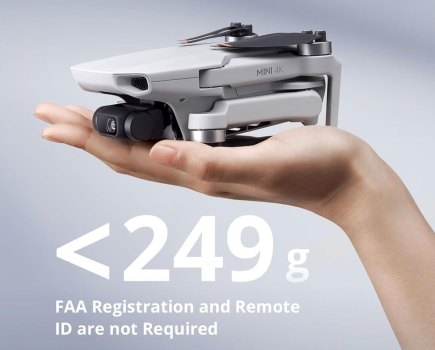In the world of film photography, when it comes to picture quality, one truth is universal: a good big one will always beat a good little one. The ‘little one’ in question here is 35mm – the film size that dominated camera design from 1925 right up until the digital age. The ‘big one’ is roll film, in the shape of the 120 size still available today. But don’t think that means having to forsake single lens reflexes (SLRs) to use creaky old folding cameras. A good number of SLRs were made for 120 film. Today, highly specified, beautifully made, second-hand roll film reflexes can be bought for a fraction of the cost of a modern DSLR.
To get an idea of how a 120 roll film reflex works, let’s take an overview of one of the best.
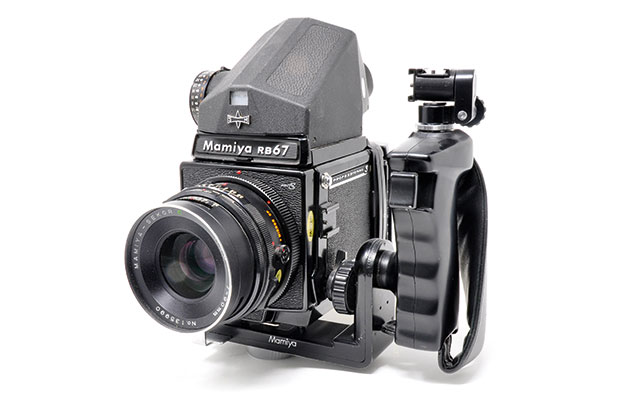
With an eye-level prism finder fitted, the addition of a handgrip helps to stabilise the Mamiya RB67. Credit: John Wade
Mamiya RB67 Pro S
- Launched 1974
- Format 10 exp 6x7cm
- Guide price today £300-450
Like many of its contemporaries, the RB67 adopts a modular design. At its heart is a box containing the reflex mirror, focusing screen and a lens panel that extends on bellows. The film is loaded into a magazine back that fits to the rear. Lenses fit via a breach-lock at the front. Waist-level and eye-level viewfinders slot over the focusing screen on the top.
The camera is usually found with a standard 90mm f/3.8 Mamiya-Sekkor C lens that stops down to f/32 and focuses from 4 feet to infinity. A Seiko mechanical shutter situated in the lens is speeded 1–1/400sec, while M and X synchronisation means flash can be used at any shutter speed. A range of accessory lenses from 37mm fisheye to 500mm telephoto is available.

Breaking down the Mamiya RB67. Left to right:120 roll film back, cut film holder, body and bellows (showing the focusing scale for different focal lengths), and standard lens. Metered prism and waist-level viewfinders are shown above. Credit: John Wade
Thanks to the built-in bellows which extend 46mm from the body, close-up photography is possible, right down to 3.9cm camera-to-subject distance when a 50mm wideangle lens is in use. Focusing scales for different focal lengths are revealed on the side of the camera as the bellows are extended.
The film back incorporates a dark slide to protect the film if it is changed mid-roll, but which must be pulled out before an exposure is made. The back can be rotated for landscape or portrait pictures. Film wind is by lever. Other film backs are available including one for motorised film advance, another for 20 exposures on 220 film, a special back for shooting 6×4.5cm images, a Polaroid back and even holders for plates and cut film.

The RB67 is usually found with its waist-level finder. Credit: John Wade
The waist-level viewfinder with which the camera is usually equipped incorporates a focusing hood with magnifier and unfolds to reveal a 7x7cm screen, with indicators to show which way the back is oriented. The mirror is lowered by a lever on the side of the body, apertures and shutter speeds are set on rings around the lens, focus is by turning a body-mounted knob to extend and retract the bellows and the shutter is released by a button beneath the lens. On exposure, the reflex mirror flips up and doesn’t return until the body lever is depressed again.

Inside the 120 roll film back, ready for loading. Credit: John Wade
Although the RB67 is best used on a tripod, it is easy to operate handheld with a waist-level viewfinder. Handholding the camera with an eye-level viewfinder is more clumsy, but is made easier by the addition of a heavy-duty grip that screws into the tripod bush, adds an accessory shoe for a flashgun and links a trigger to the shutter release.
Other accessories available for the RB67 include a range of grips, auto extension tubes, manual and metered waist-level and eye-level prism viewfinders with eye- correction lenses, a sports finder, interchangeable focusing screens, bellows lens hood and more.
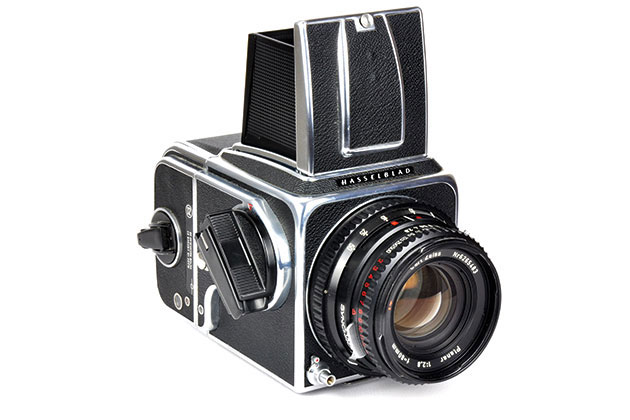
Hasselblad 500C/M: expensive, but top quality. Credit: John Wade
Hasselblad 500C/M
- Launched 1970
- Format 12 exp 6x6cm
- Guide price today £900-1,200
Hasselblads break down into the traditional modular design of body, lens, film back and viewfinder. Early cameras used focal plane shutters, but with the Hasselblad 500C, launched in 1957, a switch was made to lens integral mechanical leaf shutters, speeded 1-1/500sec. The 500C/M is an upgrade of the Hasselblad 500C, notable for the ease with which focusing screens can be exchanged. Look for one with the special bright screen to increase viewfinder brilliance. A wide range of lenses and accessories is available. Hasselblads are expensive, but their quality is legendary.
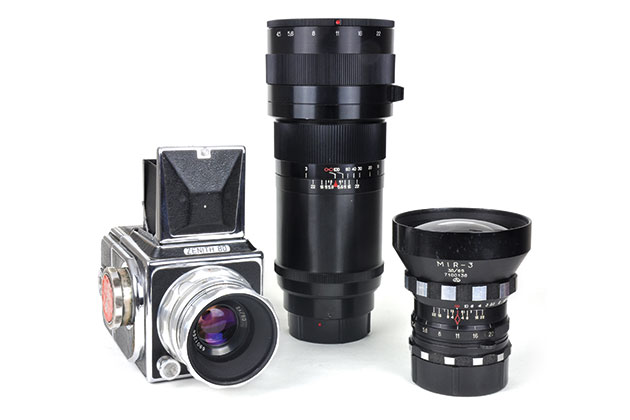
Zenith 80 with standard lens fitted, plus telephoto and wideangle lenses. Credit: John Wade
Zenith 80
- Launched 1972
- Format 12 exp 6x6cm
- Guide price today £90-150
If you fancy a Hasselblad but your budget won’t stretch to it, try this Russian copy of a Hasselblad 1000F. Its usual standard lens is an 80mm Industar, but a 65mm f/3.5 Mir-3 wideangle and a 300mm f/4.5 Tair-33 telephoto were also made for the camera. The shutter is mechanical, but a word of warning: shutter speeds must be set before film winding. Setting the shutter after winding will jam the mechanism. Despite its relatively low cost, it’s a good solid camera capable of quality results.
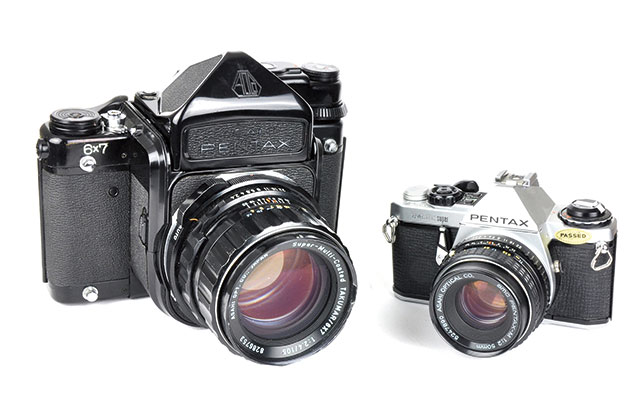
Pentax 6×7, side by side with a Pentax ME Super for scale, giving an idea of its size. Credit: John Wade
Pentax 6×7
- Launched 1969
- Format 10 exp 6x7cm
- Guide price today £400-600
Here’s a camera that you can use like a giant 35mm SLR, but with the image size and quality of a roll film camera. It can be equipped with a metered eye-level viewfinder or a non-metered version plus a waist-level finder. The standard lens is usually a 90mm focal length, but a range from 35mm fisheye to 1,000mm telephoto is also available. The electronic focal plane shutter offers speeds of 1-1/1,000sec.

The Bronica ETRS shoots a more economical 6×4.5cm image. Credit: John Wade
Bronica ETRS
- Launched 1979
- Format 16 exp 6×4.5cm
- Guide price today £200-250
For more economy, while still shooting a decent size image, the Bronica ETR, launched in 1976 and later upgraded as the ETRS, is worth a glance. The lens-integral shutter is electronic and speeded 8-1/500sec, but defaults to a 1/500 mechanical speed if the battery fails. Waist-level and eye-level viewfinders are available along with a wide range of lenses and accessories.
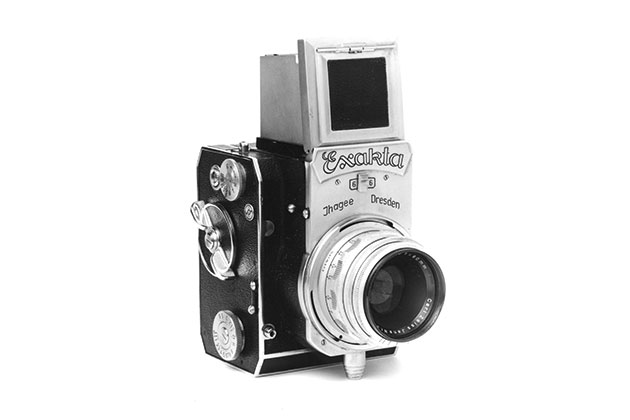
Exakta 66 marked a departure for its manufacturer from the more usual Exakta 35mm SLRs. Credit: John Wade
Exakta 66
- Launched 1953
- Format 12 exp 6x6cm
- Guide price today £700-1,000
The Exakta name is usually more associated with 35mm SLRs, and the first 66 model did resemble a large 35mm camera. But in 1953 the Exakta camera was redesigned into this more stylish version. It features a waist-level viewfinder, has a detachable film back and accepts a wide range of interchangeable lenses. The mechanical shutter speeds run from 1/1,000sec down to an incredible 12 full seconds.
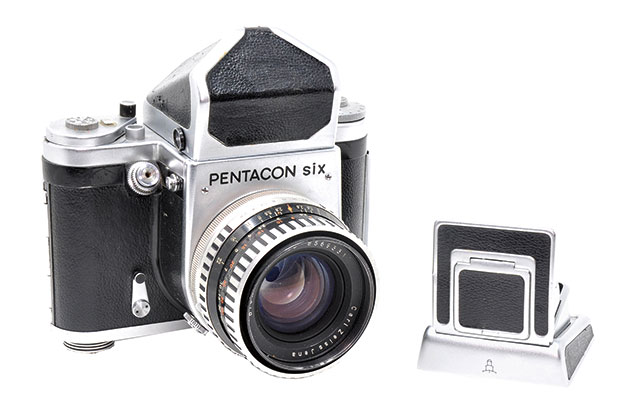
Pentacon Six with eye-level viewfinder fitted and waist-level finder. Credit: John Wade
Pentacon Six
- Launched 1956
- Format 12 exp 6x6cm
- Guide price today £200-300
If you like your roll film reflexes to handle like big 35mm SLRs, but want one half the price of a Pentax 6×7, then go for a Pentacon Six. You don’t get an interchangeable film back, but you get a choice of eye-level or waist-level viewfinders and lenses made by prestigious names like Zeiss and Schneider. Controls such as the film wind lever, mechanical shutter speed dial and aperture ring are all exactly where you would expect to find them on a smaller 35mm camera.

Corfield 66, a rare English-made roll film reflex. Credit: John Wade
Corfield 66
- Launched 1961
- Format 12 exp 6x6cm
- Guide price today £150-200
Made by the English Corfield factory, best known for its range of 35mm Periflex cameras, this is an all- mechanical roll film SLR with a waist-level viewfinder, shutter speeded 1/10- 1/500sec and a detachable film back. The Lumax 95mm f/3.5 standard lens is interchangeable, but the lens mount is unique and no other lenses were made for the camera. Only about 300 were made, so today this is a bit of an oddity which although fun to use, is likely to appeal more to collectors.
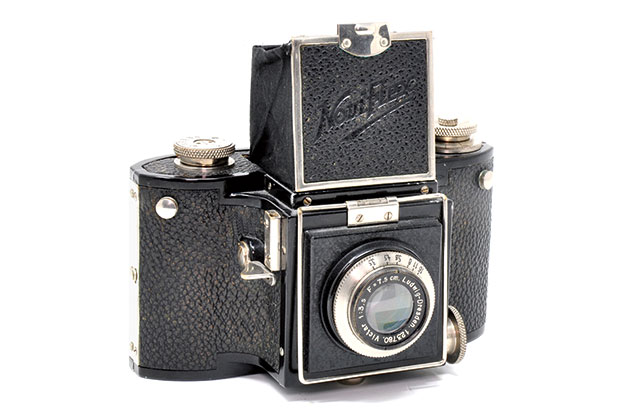
The Noviflex is a collector’s camera, but it’s still very usable. Credit: John Wade
Noviflex
- Launched 1934
- Format 12 exp 6x6cm
- Guide price today £150-200
Predating the earliest Hasselblad by more than a decade, this was the first SLR to shoot 6x6cm images on 120 film. That makes it a collector’s item these days, but it’s also a very usable camera, although it has neither interchangeable lenses nor a detachable film back. Reflex viewing is available only with the fixed waist-level finder, but the camera can be used at eye-level thanks to a fold-up wire frame at the front and a back sight at the rear. The mechanical focal plane shutter offers 1/20-1/1,000sec speeds.

The Kiev 6C ready for eye-level shooting, plus its accessory waist-level viewfinder. Credit: John Wade
Kiev 6C
- Launched 1977
- Format 12 exp 6x6cm
- Guide price today £90-120
Here’s another gigantic 35mm SLR lookalike. There’s no detachable film back, but there is a choice of waist-level, plain or through-the-lens (TTL) metered eye-level viewfinders. It shares its lens mount and choice of lenses with a Pentacon Six, and the 90mm f/2.8 Vega lens with which it is usually equipped is known for its sharpness. The mechanical shutter offers 1/2-1/1,000sec speeds, but the left-handed shutter release makes the camera awkward to use handheld.
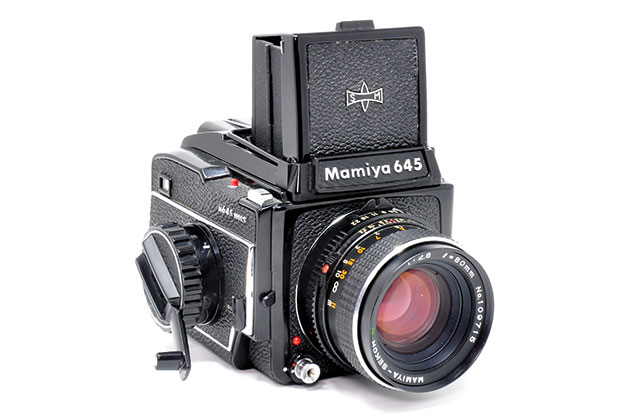
Mamiya M645 1000S shoots fifteen 6×4.5cm exposures. Credit: John Wade
Mamiya M645 1000S
- Launched 1976
- Format 15 exp 6×4.5cm
- Guide price today £220-280
The Mamiya RB67’s little brother was originally launched in 1975 and upgraded a year later with a higher top shutter speed, self-timer and depth-of-field preview. So of the two early models, the upgraded 1000S is the better one. It offers interchangeable viewfinders and focusing screens, but there is no interchangeable film back. The electronic focal plane shutter is speeded 8-1/1,000sec and there is a mirror lock-up facility. The standard lens is a Mamiya-Sekor C 80mm f/2.8, but a full range is available from 24mm to 500mm. A second shutter release on top of the body is convenient for use at waist level. This and the M645 cameras that followed make ideal introductions to quality, budget-priced, roll film reflex photography. Unlike the early metal cameras, however, the later cameras were made of plastic.
Choosing a roll film reflex
- Which image format works best for you?
- Traditional box shape camera or large 35mm SLR lookalike?
- Waist-level or eye-level viewfinder?
- Plain focusing screen or rangefinder equipped?
- Fully manual or metered?
- Are you prepared to use a tripod, or do you want to only use the camera handheld? If the latter, a waist-level viewfinder will suit you better.
- Can you buy 120 film easily? If not, run a search on Amazon: www.amazon.co.uk/s?k=120+roll+film.
- Can you get 120 film processed? If your local high street processors can’t handle it, try www.digitalab.co.uk/film-processing.
- Although many roll film reflexes are relatively cheap to buy, their lenses and accessories remain expensive. Take this into account when making your choice.
Using a roll film reflex
- The movement of large mirrors can create undue vibrations. For this reason, use a tripod when you can, or select a shutter speed of 1/250sec or higher when handholding.
- If you intend to handhold the camera with an eye-level viewfinder, consider adding a hand grip to help reduce movement during exposure.
- If you have been brought up on shooting in the 1:1.5 format of 35mm or most digital cameras, think carefully about changing your approach to picture composition when faced with a roll film square format.
- Large waist-level viewfinder screens are impressive, but because they are big, it’s easy to only look at the centre of the screen when composing a picture. Keep the camera steady and ensure you look at all four corners as well.
- Use the built-in magnifier on a waist-level viewfinder for fine focus.
- Remember, you have only a few pictures to each roll of film. Use them wisely and think much more about the picture, its composition, and exposure before firing the shutter.

A roll of 120 film, compared to 35mm. Credit: John Wade
More about 120 film
What is 120 film?
The 120 roll film size was introduced in 1901 with the launch of the Kodak No. 2 Brownie. Over the years many roll film sizes came and went, but the 120 size endured. Unlike 35mm film, which is contained in a cassette, 120 is wound onto a spindle, attached to light-proof backing paper with a leader and trailer at each end to prevent exposure to light during loading and unloading. The backing paper contains numbers observed through a red window in the camera back to indicate how far the film is wound between exposures. Some cameras dispense with the red window and use an auto mechanism that stops the film being wound when it has been advanced the right amount, the lock freeing itself ready for the next wind as an exposure is made.
Films available
120 size roll film is available from specialist dealers and on Amazon (Ilford, Kodak, Fujifilm, etc.). Look for three types:
- Black & white negative for producing mono prints in a darkroom, or by scanning and reversing. Examples: Ilford Delta 400, Pan F, FP4 and HP5.
- Colour negative for producing colour prints in a darkroom or by scanning and reversing. Examples: Fujifilm 400H, Kodak Ektar 100 and Portra 400.
- Colour-reversal film for E6 processing to make direct positive transparencies that can also be scanned. Examples: Fujifilm Provia 100F and Velvia 50.
Resurrecting classics
A quick browse around eBay might turn up a Rada or Rollex film back. These were made for fitting to plate or cut film cameras in place of the plate or film holders. Loaded with a roll of 120 film and with the back’s dark slide removed, the holders can bring new life to old cameras. They mostly shoot eight pictures 6x9cm.







